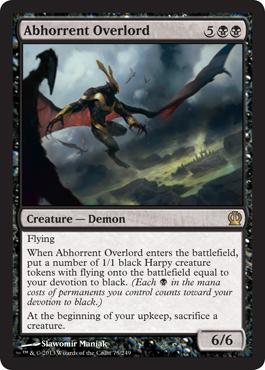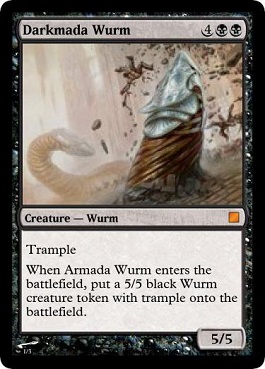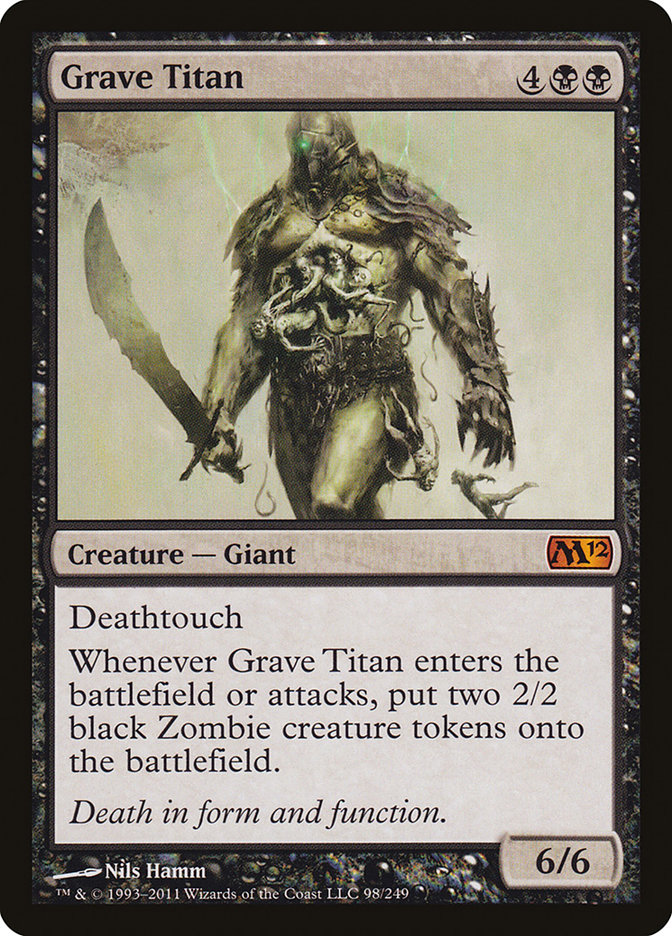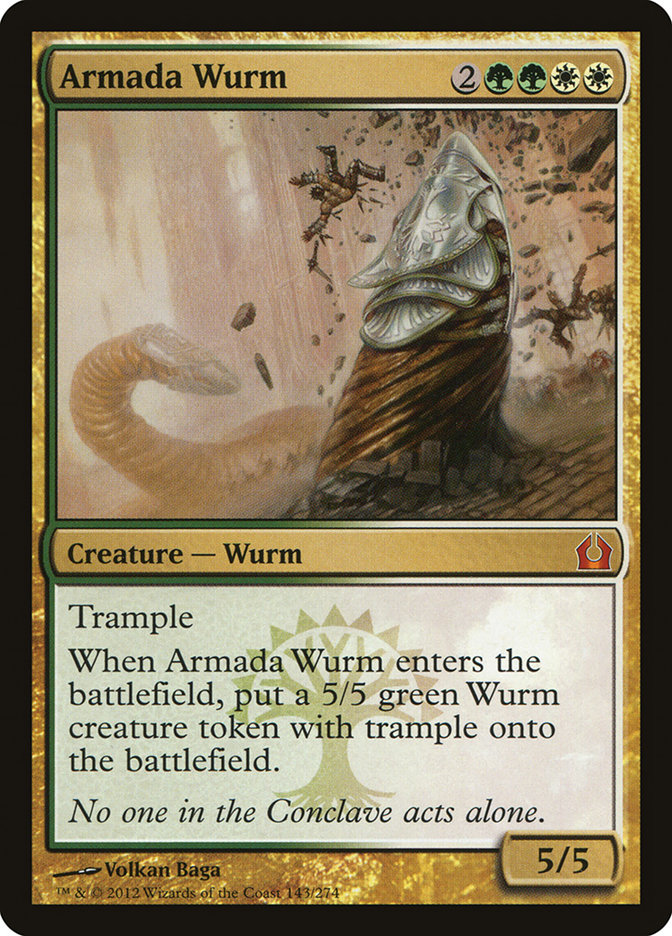Monsters.
Heroes.
Gods.
Greek mythology remixed and combined with a full-on enchantment block?
Preview season for Theros is here. We have already touched on the new monstrosity mechanic, including a look at the dubiously named Polukranos, World Eater. I’d like to devote today to another new(ish) mechanic and one of the upcoming cards from Theros that features it:

It’s kind of interesting to see WotC take a mechanic that flopped the first time around (chroma), clean it up, reflavor it, and turn it into something awesome. Why does devotion look like it’s going to be so much cooler than chroma?
Well, the most obvious answer is because chroma kind of makes it clear you are just counting colors. It breaks the fourth wall in a way and tells a story that we are just sitting around a card table. On the other hand, being rewarded for your devotion to a color is a very real experience, particularly when demons and gods are the ones requiring devotion.
It’s also nice to be able to think about this mechanic without the loudly distracting hybrid theme from Eventide. Besides, a mechanic that appeared on just a few random cards from Eventide is not necessarily the best way for people to remember and cherish a mechanic.
One of the things I really like about devotion is how much the cards feel like devotion is giving you a bonus on top of everything else. Abhorrent Overlord is the perfect example. His devotion ability always works because at the very least he brings two Harpys to the table himself. At that point, you are already up to eight power’s worth of fliers. Everything else is just a bonus.
Eight power’s worth of flying bodies for seven mana is already pretty sweet. It’s not quite good enough for Standard play most likely, but it isn’t embarrassing. So how many Harpys do you need before you’re getting your money’s worth?
Let’s start with an awfully unfair comparison:
Grave Titan is one of the better creatures in Magic’s history and had a very warping impact on a number of formats. It was generally better than six-drops are supposed to be. Still, how do the two measure up?
Grave Titan costs a mana less, gives you 2/2 Zombies instead of 1/1 fliers, has deathtouch instead of flying, and makes two more tokens every turn instead of having the devotion ability to make more tokens. How do these differences add up?
While Abhorrent Overlord and Grave Titan have the same size body, the Demon makes better use of it with flying (a fantastic ability on a 6/6), whereas the Giant has a keyword that contributes very little (deathtouch, when almost anything it would fight would die anyway). Already this is a huge advantage for the Overlord, perhaps almost a mana’s worth.
Interesting . . .
Now we come to the tokens themselves. In general, a 2/2 Zombie is worth more than a 1/1 flier, but not actually by that much. After all, when you’re dealing with six- and seven-cost spells, it is generally late enough in the game that there is a reasonably great chance that 2/2 ground creatures will be somewhat obsoleted, or at the very least provide less utility than a 2/2 normally would. Conversely, fliers can hold their value more, as they are less likely to be trumped by bigger creatures.
While I’d give the advantage to the 2/2 Zombies over the 1/1 fliers, it is definitely close enough to be interesting.
Finally, this brings us to Abhorrent Overlord’s devotion to darkness "kicker" versus Grave Titan’s attack trigger. How good is making two more Zombies every turn? It’s a lot of raw power, but it’s also power that you don’t always want or need.
How can we evaluate how much that ability is really worth to us? Well, one crude rule of thumb for evaluating card power is to imagine that a creature that gives us something every time it attacks (if it lives) is generally in the ballpark of power as a card that gives it to you once up front regardless of whether it lives or not. Of course, this equation varies heavily depending on often much creature removal people play. The more removal people have, the more you want to get paid up front.
Anyway, Grave Titan, like Abhorrent Overlord, pays you two tokens up front. Where they diverge is that Grave Titan lets you get two more every turn, whereas Abhorrent Overlord has the ability to give you some number of extras when played. How do these compare?
Well, if we set aside the value of the tokens for a moment (since 2/2s are worth slightly more than 1/1 fliers), it is at least in the right ballpark to say that you need to average two extra tokens when played to make up for the attack trigger ability. If getting two per turn sounds way better than two extra up front, think of it this way.
- The turn you play the creature, the upfront version is ahead by two tokens.
- The turn after, if the attack trigger version lives, it aspires to make two tokens, though it is still behind since it has not had the use of those two tokens for two turns (doing less damage, having fewer blockers, etc.).
- Finally, the turn after that, if the attack trigger version is still living and attacking, it gets ahead on tokens (though it is still behind on damage dealt from its tokens).
- Then the question becomes how many times can a creature this large attack before you have already won the game anyway?
This leads us to a starting spot of wanting the devotion to black to be worth an average of two extra tokens (assuming freaking Grave Titan is where we are getting our blueprint). If we pull this off, we get ten power’s worth of fliers split across five bodies. That’s a two-turn clock that still gives us both halves of a Lingering Souls even if our opponent finds a way to deal with the 6/6 Demon!
So where does this leave us?
I would rather have flying and get 1/1 flying tokens than have deathtouch and make 2/2 Zombies. The devotion condition is harder to fully understand, as we haven’t seen the new set and what support there is for it, but in general I would guess is at least approximately as strong as the attack trigger condition. It is contextually far more powerful but misses out on one of Grave Titan’s great strengths—the ability to just play it by itself and have it take over the game.
Generally speaking, I’d say Abhorrent Overlord is at least in the ballpark of Grave Titan in terms of impact on the game and the amount of power it brings, and it’s possibly slightly stronger.
The catch?
It costs seven mana, not six.
If Abhorrent Overlord cost six mana, it could have a chance of being as good as Grave Titan. However, it does have three very big advantages that Grave Titan doesn’t have despite costing seven.
- It is more abusable. If you find a way to play it onto a board with permanents, it doesn’t take much for you to create an absolutely overwhelming board presence. A couple of Underworld Connections and a Lifebane Zombie and suddenly you are talking about fourteen power’s worth of fliers spread across nine bodies!
- Grave Titan isn’t legal. This is important not just because "the rules say so, blah, blah, blah." It is important because the era where Grave Titan was legal was balanced around it existing. Mana Leak, Jace the Mind Sculptor, Bloodbraid Elf, and more were all legal as well at different points.
- Grave Titan was one of five Titans that were all somewhat similar in design and power level. Because there were so many, players knew to build their decks to combat them. Abhorrent Overlord is not one of five cards exactly like it. As a result, the format is likely to be slightly less focused on fighting it.
Ok, can we compare Abhorrent Overlord to something actually in the format?
Scion of Vitu-Ghazi and Armada Wurm are the first two creatures that come to mind. Neither is actually a black creature, which would make for a better comparison, but they do have some similarities. Still, it is important to view them under the proper lens.
Armada Wurm gives you two 5/5 tramplers for six mana, which at first glance seems like it could even compare to Grave Titan. The catch? Armada Wurm’s casting cost is a lot worse than Grave Titan’s. It’s not just that having four specific mana symbols is so much more than two; it’s that green and white are the two colors that appreciate big bodies like this the least. They get them all the time and are a dime a dozen!
How many great fatties does black ever get? Not a ton, right? A few, but nothing like green and white have access to. Just imagine if Armada Wurm had Grave Titan’s casting cost:

That card would be insane! Can you even imagine how sick of a finisher this would be in many midrange and control decks?
Ok, so there aren’t really any perfect comparisons for black six- or seven-drops. The good news is that means there is little competition, giving Abhorrent Overlord a greater chance of seeing play. The bad news? He still costs seven, which increases the probability that he is merely "solid" while Grave Titan was actually amazing.
So what about actually putting Abhorrent Overlord to good use? This is obviously going to depend largely on cards in Theros and particularly how much support there is for a devotion-themed deck. Each color has a "god" that is a legendary creature enchantment that starts off as an indestructible enchantment with some sweet abilities. If and when you have enough devotion to the color (five blue mana symbols for the blue one), it awakens, becoming a creature.
If black’s god is powerful, now we are talking about two different incentives to fill the board with black mana symbols. This doesn’t just mean playing these cards in more decks; it means Abhorrent Overlord summoning ten or more creatures more often. Just looking at M14 and Return to Ravnica block, a number of black creatures and enchantments jump out as worthwhile considerations for a dedicated devotion to black deck.
Dark Prophecy is an obvious one, as it brings so many black mana symbols to the table. In addition to giving you three more 1/1 fliers when you play your Overlord, it gives you a way to turn them into added value. Now, if your opponent sweeps the board, you are drawing six cards!
Still, Dark Prophecy is a challenging card to make sure we are getting good value out of. You have to jump through more than a few hoops to get your money’s worth. An easier Necropotence variant to maximize is Underworld Connections. It only has two black in the cost, but it is already a proven tournament winner.
One of the nice things about enchantments as a means of fueling devotion is that they tend to die less than creatures. Now, it is possible that Theros being an enchantment block means that a lot more people end up playing enchantment removal and this is less true than it normally would be; however, until we have reason to believe that is the case, it is something of a feature to be able to dodge Supreme Verdicts and the like.
Additionally, a lot of board positions you would realistically encounter that involve a devotion to black so great that you make eight flying tokens are already won games. If you have a Desecration Demon; a Liliana of the Dark Realms; and an Obzedat, Ghost Council, how much do you really need the board presence Abhorrent Overlord gives you? Now, on the other hand, you might actually have a board with two Underworld Connections and a Lifebane Zombie that is miles from under control. It is not that those cards are bad; they are just giving you advantages in other places besides the battlefield. Black permanents like that are perfect to combine with the Overlord since under those conditions you actually really want what the Overlord brings to the table.
In addition to Underworld Connections and Dark Prophecy, we should be looking for other black enchantments from Theros that are likely to sit on the table. If there is a good black creature enchantment that neutralizes a threat without killing it, that could be the perfect addition (particularly if it costs BB).
If you’ve ever played a Sphere of Safety deck, then it should be obvious just how many mana symbols you can end up with incidentally. Black usually doesn’t have as many random enchantments lying around as green, blue, or white, but this is an enchantment block, so you never know. Besides, there are cards that reward you for a devotion to white, so Blind Obedience, Sphere of Safety, and Pacifism all help. Want to show your devotion to green? Verdant Haven and other such enchant lands are perfect.
As far as securing a greater devotion to black, we want to be careful to balance card quality with mana symbols. It is worth more to us to have more black mana symbols, but not so much that we just throw out all of our best cards and play nothing but the most difficult cards to cast in the format. Lifebane Zombie is just a great Magic card, so it would be totally reasonable to play it maindeck on its own. That it happens to fuel Abhorrent Overlord starts turning it from a role player into a top tier choice.
Desecration Demon isn’t as natural of a fit with Abhorrent Overlord since it tends to have a pretty big impact on the board, but it is totally reasonable to play a Desecration Demon on turn 4 and start making a dent in your opponent’s creature supply. If your opponent has creatures, they may be able to slow you way down with a few choice sacrificial offers. Abhorrent Overlord can be a nice follow-up a few turns later.
Nightveil Specter is kind of a fun option. For the purposes of Devotion, hybrid Dimir mana symbols count as both devotion to black and devotion to blue. Nightveil Specter definitely leads us to want to play mana fixers, such as Prophetic Prism, so that we can better capitalize on the cards we steal, but this doesn’t interfere with our Overlord plan at all. We do want to be careful not to just fill our deck with cards that cost lots of black mana but don’t fit our game plan. If Nightveil Specter is going to be right, he probably needs to be respectable even in the games we don’t draw an Overlord.
While mono-black isn’t necessary to prove one’s devotion to black, it is an obvious place to look. One Gatecrash creature that gives us another incentive to play mono- or nearly mono-black is Crypt Ghast. Not only does he let us drain our opponents over and over, but he is a walking Mana Flare that lets us play Abhorrent Overlord the turn after we play him even if it’s just turn 5. If we played a Lifebane Zombie or Underworld Connections on turn 3, we’re getting eleven power’s worth of fliers (and draining our opponent). That is often going to be lethal next turn!
Building a dedicated devotion to black deck is going to be tough until we see more of Theros because what we’re really looking for is a good BB two-drop, and if there’s a good BBB three-drop, we could be really rocking and rolling. My guess is that WotC wouldn’t have gone to all the trouble of making this a major mechanic if they weren’t going to give it the support it needs to at least be a possible major strategy (if not a devotion to black, at least a devotion to one or two colors). Historically, mono-black has gotten more love than most monocolor strategies, so there is a good chance it’s at least a fringe strategy once we have all of Theros.
Of course, there is no reason an Abhorrent Overlord deck needs to be mono-black. Mutilate is even rotating out! How much do you actually need to build towards the Overlord to make it worth it? What if you just played Esper with Lifebane Zombies, Underworld Connections, Sin Collectors, Blood Barons, and any number of other black permanents that sometimes happen to boost one of your couple Overlords? Admittedly, any seven-drop would have to compete with Angel of Serenity, which is far from trivial.
Ok, what if the deck wasn’t white? What about Jund? Now, we gain the advantage of green accelerators, letting us play our Overlord a little earlier than turn 7, and there isn’t a specific seven-drop that would outclass us here.
Yeah, yeah, Grixis is a possibility as well, particularly since their fatties are stuff like Aetherling, which is a very different sort of card and not a direct competitor. This would have to be a Grixis deck with a lot of permanents, which is a bit odd but at least worth considering.
Why do I keep suggesting options involving red? I’m not 100% sure, but it does feel like red might offer some things we want without immediately obsoleting the Overlord. It’s tempting to go towards something like a Junk deck, as that is the type of deck that would normally be in the market for all those bodies at that cost. Unfortunately, we run face first into the Angel of Serenity problem again. Two colors (or a possible very light third color splash) is more likely the better starting point (other than just straight mono).
There are more ways to abuse Abhorrent Overlord than merely making lots of tokens. What about actually getting paid because of how many tokens he makes? For instance, if you combine Abhorrent Overlord with a Lifebane Zombie (make sure the coast is clear) and an Ogre Battledriver, you are attacking for 24 the turn you play the Overlord. Bronzebeak Moa is a much messier way to try to do a similar thing, but depending on how into it you are, it might be worth a look.
Beck // Call is a bit expensive to play the same turn you play your Overlord, but it’s worth keeping an eye out for any Theros cards that trigger whenever a creature enters the battlefield.
I’d love to be able to leave you with an Abhorrent Overlord decklist to start with, but there is just too much missing that hasn’t been spoiled from Theros yet. One of the interesting aspects of this mechanic is how much it pushes us away from Return to Ravnica’s three-color-enabling world. Will it be just a fringe mechanic, will it appear in random places on account of being stapled to good rate cards, or will a dedicated devotion deck be a regular part of the metagame?
Instead, I leave you with some food for thought on the upcoming rotation.
Top 10 Cards Rotating Out When Theros Hits
10. Hellrider
9. Avacyn’s Pilgrim / Arbor Elf
8. Pillar of Flame / Searing Spear
7. Geist of Saint Traft
6. Thundermaw Hellkite
5. Huntmaster of the Fells
4. Farseek
3. Olivia Voldaren
2. Thragtusk
1. Restoration Angel
Obviously there are a lot more than ten important cards rotating out, and I kind of cheated by not including any of the lands (rather than lumping them all together in a clear number one spot). Let me know which nonland cards should have been on this list (and which cards you’d bump to make room). Is it insane for Snapcaster Mage to not be on here? What about Falkenrath Aristocrat? Rancor? Bonfire of the Damned? Liliana of the Veil? Lingering Souls? Innistrad block was such a sick set of sets, so it’s no surprise to see so many homeruns lined up.
I’m going to be in Cincinnati this weekend, so be sure to tune in to the SCGLive where Shaheen Soorani and I will be covering all the action and, if we find time, possibly debating whether Preordain was a playable Magic card (before it was banned).
Have a great weekend!
Patrick Chapin
"The Innovator"




